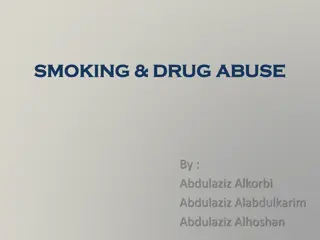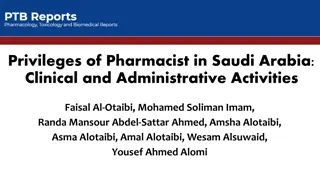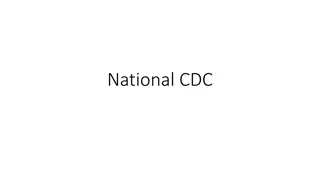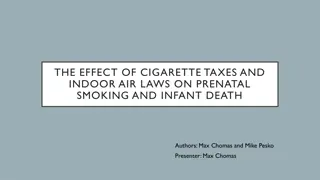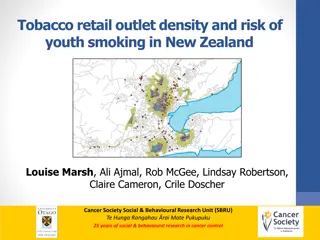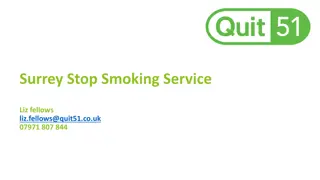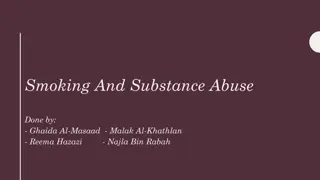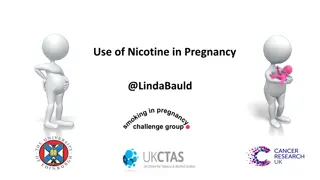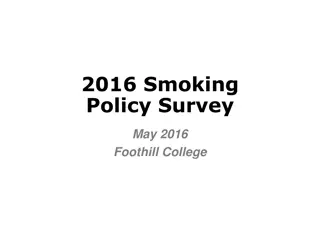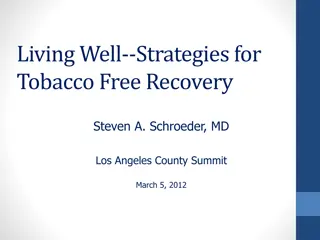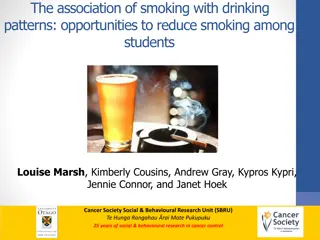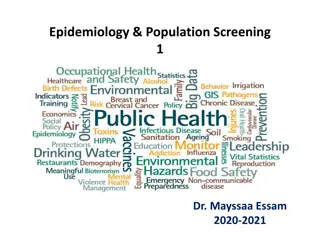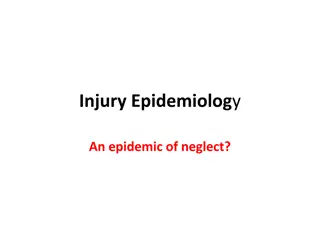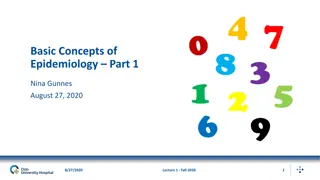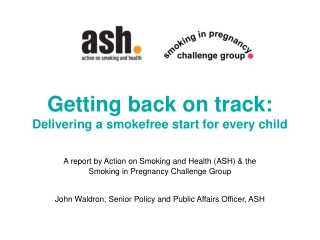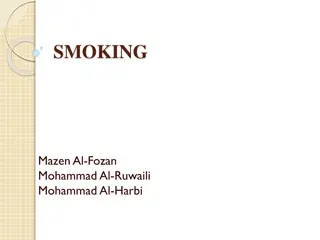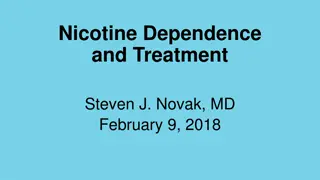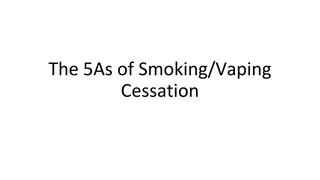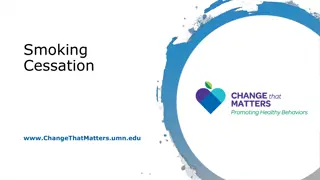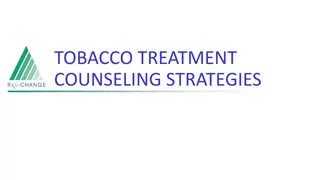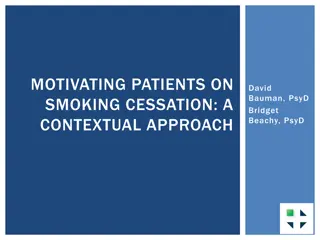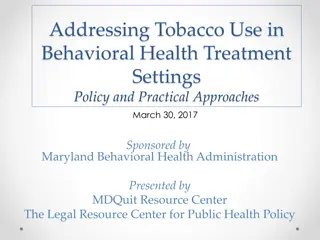Epidemiology of Smoking in Saudi Arabia
The Epidemiology of Smoking in Saudi Arabia is explored through the Saudi Health Interview Survey (SHIS), revealing that 12.1% of Saudis currently smoke tobacco, with varying prevalence across genders and age groups. The survey, conducted in 2013, provides insights into smoking patterns, daily consumption rates, and use of different tobacco products among the Saudi population aged 15 and older.
Download Presentation

Please find below an Image/Link to download the presentation.
The content on the website is provided AS IS for your information and personal use only. It may not be sold, licensed, or shared on other websites without obtaining consent from the author. Download presentation by click this link. If you encounter any issues during the download, it is possible that the publisher has removed the file from their server.
E N D
Presentation Transcript
Group 3 Epidemiology of smoking in Saudi Arabia [Presenter & editor] Types of smoking Risks of smoking Effect of passive smoking (children / pregnancy) How to help smokers to Quit Updates on pharmacological management, smoking cessation medications Nicotine preparations, varniciline, bupropion Faris Aljaafar OSCE station role play Hamad alkhudhayri Saad Al-Qahtani 436101499 436100168 Talal alhuqayl Abdulaziz Aljasser 436100762 436100502 Majed belal alzin Hassan alshammari 436103152 436103354 436100645 436103141 436102493 Abdulaziz shadid Mohammed nasr
Objectives: 1.Epidemiology of smoking in Saudi Arabia. 2.Types of smoking. 3.Risks of smoking. 4.Effect of passive smoking (children / pregnancy). 5.how to help smokers to Quit. 6.Updates on pharmacological management , smoking cessation medications. 7.Nicotine preparations.
Epidemiology of smoking in Saudi Arabia : The Saudi Health Interview Survey (SHIS) is a large national survey aimed at assessing chronic diseases, health behaviors, and risk factors among adults aged 15 or older in the Kingdom of Saudi Arabia. The survey consists of a household roster, a questionnaire and physical measurements, and a lab-based biomedical examination. The questionnaire included several questions on tobacco use. The survey was developed in partnership between the Ministry of Health in Saudi Arabia and the Institute for Health Metrics and Evaluation of the University of Washington.
Methodology used : SHIS is a multi-stage nationally representative sample survey with probability of selection symmetric to the size of the population of adults 15 years or older. The survey was conducted in all Saudi regions, and data were collected between March and July 2013 from 10,827 participants. The sample was weighted to reflect the Saudi population aged 15 and older based on probability of selection and post-stratification.
Findings : findings are representative of the Saudi population aged 15 years and older. Overall, 12.1% of Saudis reported that they currently smoke tobacco. This prevalence was 23.7% among males and 1.5% among females. The prevalence of tobacco smoking varied by age; among those aged 65 and older, the prevalence of tobacco smoking was the lowest: 6.5% (9.7% among males and 1.8% among females). Saudis aged 55 to 64 years had the highest prevalence of current smoking (15.6%) with 24.7% among males and 4.2% among females.Daily tobacco smoking is 11.4 with ( 21.5% among males and 1.1% among females). 11.4% (21.5% among males and 1.1% among females) of smokers consume cigarettes daily with an average of 15.0 cigarettes per day. 11.2% of Saudis consume shisha daily (20.9% for males and 1.4% for females). 0.3% of Saudis consumed smokeless tobacco products daily (0.5% among males and 0.2% among females). On average, Saudis start smoking at age 18 (males at 19 and females at 21). Overall, 29.7% started smoking before the age of 15, and 60.9% started smoking before the age of 18.
17.2% of Saudis are exposed to secondhand smoke at home, with an average of 5.1 days of exposure per week. This secondhand exposure is 20.9%, with an average of 4.8 days of exposure per week, for males, and 13.1%, with an average of 5.5 days of exposure per week, for females. 14.8% of Saudis are exposed to secondhand smoke at work, with an average of 2.2 days of exposure per week. This secondhand exposure at work affects 24.9% of males, with an average of 4.3 days of exposure per week, and 2.6% of females, with an average of 1.4 days of exposure per week. Among smokers, 49.1% attempted to quit smoking within the last 12 months (50.1% for males and 34.1% for females). 53.9% of smokers (54.5% for males and 45.2% for females) reported being advised by their doctor or a health care professional to quit smoking during any visit within the last 12 months.
Type of smoking: Types of Tobacco Products. Cigarettes are the most common form of tobacco used. Electronic Cigarettes or E-Cigarettes. Chewing Tobacco, Snuff Tobacco Cigars, Cigarillos, Little Cigars, and Blunts. Pipes. Hookah or Water Pipe (shisha).
Risk of smoking: Each year more than 480,000 people in the United States die from illnesses related to tobacco use ,therefore it is one of the most clearly damaging to health. Smoking contributes to a variety of non-communicable diseases, including: cancer, heart disease, stroke, chronic respiratory diseases, and diabetes. Cancer: Smoking accounts for about 30% of all cancer deaths in the United States, including about 80% of all lung cancer deaths ,Not only does smoking increase the risk for lung cancer, it s also a risk factor for cancers of the: mouth , larynx , pharynx ,esophagus ,Kidney, Cervix ,Liver ,Bladder ,Pancreas ,Stomach and Colon/Rectum
chronic respiratory diseases: - Smoking damages the airways and small air sacs in the lungs -It makes pneumonia and asthma worse, It also causes many other lung diseases that can be nearly as bad as lung cancer. Like: -COPD(chronic obstructive pulmonary disease): Smoking is by far the most common cause of COPD. Diabetes: Among male health care professionals in the US, smoking 25 or more cigarettes daily appears to double the risk of Non insulin-dependent diabetes. Heart disease: Over time, chemicals in tobacco smoke triggers plaque buildup in the arteries leading to atherosclerosis and increases the risk of having and dying from heart disease, heart failure, or a heart attack
Not all of the health problems related to smoking result in death, it can steal away a person s quality of life long before death. it causes: Increased risk of gum disease and tooth loss. Wounds taking longer to heal Decreased immune system function Decreased sense of smell and taste Premature aging of the skin Bad breath and stained teeth Increased risk for cataracts
Effect of passive smoking on pregnancy & children First what is passive smoking ? Passive smoking (Second-hand smoke) is characterized as the product released into the environment whenever someone who is smoking exhales. It can also come from the end of tobacco-containing smoking products. There are approximately 4,000 chemicals present in second-hand smoke, many of which have been determined to be related to cancer. Effect of passive smoking on pregnancy: If a pregnant women get exposed to second-hand smoke during pregnancy, both she and her baby are put at risk. Some of the health conditions associated with being exposed to second- hand smoke are: Miscarriage Low birth weight Early birth Learning or behavioral deficiencies in the child, Sudden infant death syndrome (SIDS) 1. 2. 3. 4. 5.
Effect of passive smoking on children: Almost half the world s children (about 700 million) are exposed to smoke from burning tobacco and exhaled smoke at home. Health effects on children : 1. BRAIN: Possible association with brain tumors and long-term mental effects. 2. HEART: Adverse effect on oxygen uptake and arteries. 3. LUNG: Respiratory diseases (including bronchitis and pneumonia) Asthma induction and exacerbation Chronic respiratory symptoms (wheezing, coughing, breathlessness)
How to help a smoker to quit and how to overcome withdrawal symptoms: How to help smokers to quit: Remind smokers of the importance of stopping smoking with leaflets and posters. Assess smoking status. Advise to stop and Assess willingness to change. 1-If smoker wants to stop 2-If smoker does not want to stop -Offer to refer to the smoke stop clinic. -Help him to set a quit date and stick to it. -Advise to stop smoking completely on the quit date. -Recommend Nicotine replacement therapy. -Consider offering a follow-up appointment to check progress. -Record advise given to stop smoking. -Give the smoker an advice leaflet to take away. -Repeat advise to stop.
Nicotine withdrawal symptoms: Urges to smoke (70%) Increase appetite (70%) Depression (60%) Restlessness (60%) Poor concentration (60%) Irritability/aggression (50%) Night-time awakenings (25%) Light headedness
How to overcome withdrawal symptoms? 1. Try nicotine replacement therapy Prescription nicotine in a nasal spray or inhaler Over-the-counter nicotine patches and gum Prescription non-nicotine stop-smoking medications 2. Avoid triggers 3. Physical activity 4. Practice relaxation techniques 5. Go online for support 6. Remind yourself of the benefits Feeling better Getting healthier Saving money
What Are Treatments For Tobacco Dependence? There are effective treatments that support tobacco cessation, including both behavioral therapies and FDA-approved pharmacotherapies. Research indicates that smokers who receive a combination of behavioral treatment and cessation medications quit at higher rates than those who receive minimal intervention.
Behavioral Treatments Behavioral counseling is typically provided by specialists in smoking cessation for four to eight. A variety of approaches to smoking cessation counseling are available: Cognitive Behavioral Therapy (CBT) : CBT helps patients identify and teaches them relapse-prevention skills and effective coping strategies to avoid smoking in the face of triggers. Motivational Interviewing (MI) : Studies of MI suggest that this intervention results in higher quit rates than brief advice to stop smoking or usual care. Mindfulness: In this therapy, Patients learn techniques that help them tolerate negative emotions including stress and cravings without returning to tobacco use or other unhealthy behaviors.
FDA - Approved Pharmacotherapies Nicotine Replacement Therapy (NRT): ( transdermal patch, spray, gum). NRTs stimulate the brain receptors targeted by nicotine, helping relieve nicotine withdrawal symptoms and cravings that lead to relapse. Bupropion: It was originally approved as an antidepressant. It works by inhibiting the reuptake of the brain chemicals norepinephrine and dopamine as well as stimulating their release. Bupropion has been found to increase quit rates that s why it is indicated for smoking cessation.
Varenicline: It is a partial agonist for the 42 nicotinic receptor that leads to the release of dopamine and therefore, reduce the feelings of craving and withdrawal caused by smoking cessation. Transcranial magnetic stimulation (TMS) is a relatively new approach to treat addiction. It is a physiological intervention that noninvasively stimulates neural activity in targeted areas of the brain using magnetic fields. Research on TMS as a treatment for smoking cessation is in early stages but has shown promise.Among adult smokers who had not been able to quit using other treatments, high-frequency TMS treatment significantly reduced the number of cigarettes smoked.
References: http://www.healthdata.org/sites/default/files/files/Projects/KSA/Smoking-KSA- Findings-from-the-Saudi-Health-Interview-Survey.pdf 1- http://www.healthdata.org/smoking-tobacco Rimm EB, Stampfer MJ, Colditz GA, Willett WC.Prospective study of cigarette smoking, alcohol use, and the risk of diabetes in men. BMJ 1995; 310:555-9 https://www.cancer.org/cancer/cancer-causes/tobacco-and-cancer/health-risks-of- smoking-tobacco.html https://www.nhlbi.nih.gov/health-topics/smoking-and-your-heart https://www.who.int/ceh/publications/10passivesmoking.pdf http://americanpregnancy.org/pregnancy-complications/second-hand-smoke-and- pregnancy/ Oxford Handbook of General Practice, 4th Edition (p.183) https://www.mayoclinic.org/healthy-lifestyle/quit-smoking/in-depth/nicotine- craving/art-20045454 https://www.drugabuse.gov/ (National Institute on Drug Abuse) Stead LF, Perera R, Bullen C, et al. Nicotine replacement therapy for smoking cessation. Cochrane Database Syst Rev. 2012;11:CD000146. doi:10.1002/14651858.CD000146.pub4. Stead LF, Lancaster T. Combined pharmacotherapy and behavioural interventions for smoking cessation. Cochrane Database Syst Rev. 2012;10:CD008286. doi:10.1002/14651858.CD008286.pub2 Raja M, Saha S, Mohd S, Narang R, Reddy LVK, Kumari M. Cognitive Behavioural Therapy versus Basic Health Education for Tobacco Cessation among Tobacco Users: A Randomized Clinical Trail. J Clin Diagn Res JCDR. 2014;8(4):ZC47-ZC49. doi:10.7860/JCDR/2014/8015.4279 Sousa AD. Repetitive Transcranial Magnetic Stimulation (rTMS) in the Management of Alcohol Dependence and other Substance Abuse Disorders - Emerging Data and Clinical Relevance. Basic Clin Neurosci. 2013;4(3):271- 275.
Case scenario: Mohammed nasr, 21 years old male medically free, smoker for the last 5 years presented to your clinic asking for counseling after his brother was diagnosed with lung cancer. The doctors told his brother that smoking was one of the major contribution of his illness.



